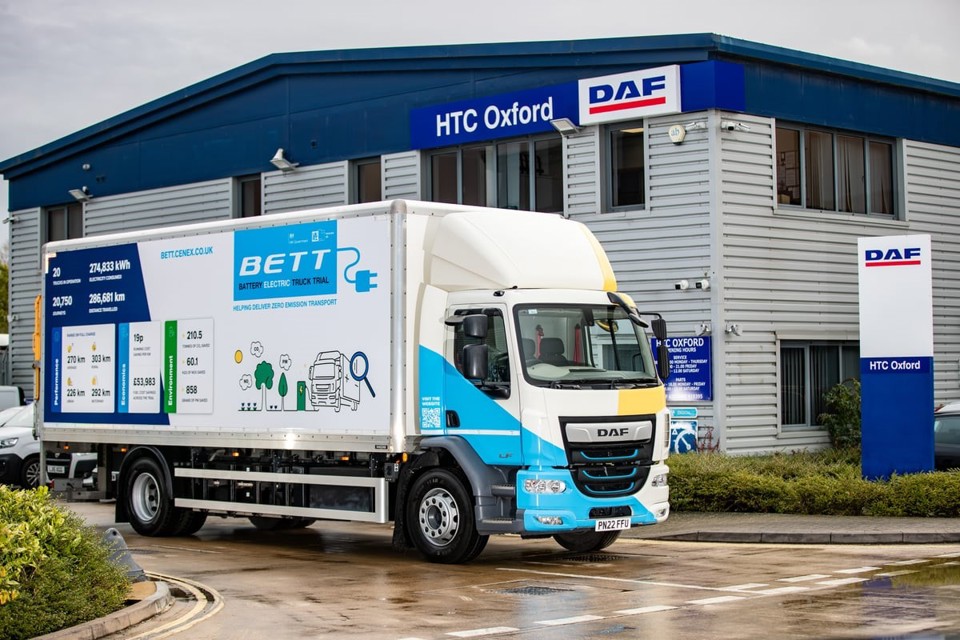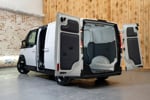While there is plenty of real-world data available for fleets to use when transitioning to electric cars or vans, the picture is less complete when it comes to the electric truck sector.
That situation has begun to be addressed, however, with the publication of the final Battery Electric Truck Trial (BETT) report following the completion of the 20-month project.
The initiative, which ran from April 2022 to October 2023, was set up following an award of funding to Daf from Innovate UK and saw 20 Daf Electric LFs – a rigid 19-tonne battery electric truck equipped with a 250kWh battery - deployed to nine fleets.
These were a mix of councils, NHS-associated and public purchasing organisations, with the vehicles completing nearly 21,000 journeys and travelling almost 287,000km.
Each vehicle was fitted with telematics technology to gather data, and this was used to update a live feed of vehicle statistics on the BETT portal.
Throughout the trial, Cenex provided Daf Trucks with specialist support in the areas of independent trial analysis and dissemination, generating evidence to show fleet operators how electric trucks can cover real-world operations.
Here we look at the main findings of the trial:
2 Driver/fleet manager acceptance
1 Factors affecting range
The overall average energy efficiency across all vehicles for the duration of the trial was 1.08kWh per km, giving a range of 270km on a full battery.
To allow for deeper analysis, Cenex also split the journeys undertaken by the trucks into three categories – urban, rural and motorway.
Urban covers slower start-stop movements, motorway includes consistent high-speed driving, while rural driving sits between them.
Efficiency varied between 0.9km per kWh for urban driving and 1.2km per kWh for rural driving, which would give maximum ranges of 226km and 303km respectively.
“The range of 270km is roughly around the range that Daf was expecting (280km), so it’s good these vehicles are meeting expectations,” says Chapa Chandrasekara, technical specialist at Cenex.
“We found that you could regain around 25% of the energy used in the urban cycle through regenerative braking, so for every 100kWh used, you can get back 25kWh of energy back into the battery to use again.”
Repeated acceleration and deceleration is an especially important factor for the efficiency of HGVs as the heavier the vehicle, the more energy it requires to both accelerate and climb up hills.
Analysis found the overall efficiency of those vehicles fitted with temperature-controlled units (TCUs) was slightly lower than those without.
However, Chandrasekara says this is because the weight of those vehicles is more than the ones with standard bodies, and not to do with having to power the TCU.
The Daf vehicles used in BETT have a gvw of 19 tonnes; its unladen weight is about 9.5 tonnes for standard body versions and 11.7 tonnes for those with a temperature-controlled body.
The temperature-controlled vehicles also carried around one tonne more payload on average, so overall their average weight was three tonnes more than the non-temperature-controlled vehicles.
The TCUs, however, did use charge from the battery which could otherwise be used for propulsion, therefore reducing driving range.
In warm conditions, the TCU consumes 3% of the total energy in the vehicles with one fitted. In cold conditions this increases to around 6%.
Total ancillaries, which also include tail lifts and cab air-conditioning, consumed 11% of charge for vehicles with a TCU and 7% in those without.
As well as ancillary consumption varying in different temperatures, the efficiency of the propulsion system also varied considerably in different times of the year.
The trial found it dropped by around 30% in winter compared to summer. Batteries tend to be less efficient in colder conditions and this could account for some of the loss, says Chandrasekara, but wind, rain and colder, more dense air all increase rolling resistance and drag which increases energy consumption.
These effects are also seen in internal combustion engined vehicles.
“From these insights, I think the effects of payload, TCUs and ancillaries are the main takeaways for fleets so they can understand what they can expect in terms of truck performance under various conditions,” says Chandrasekara.
2 Driver/fleet manager acceptance
Cenex carried out pre- and post-trial interviews with fleet managers and surveys with drivers to record their expectations and concerns ahead of the trial, and to compare these with their first-hand experiences afterwards.
The end-of-trial interviews covered fleet operations, BETT truck performance, driver training, attitudes and perceptions, environmental impact and behaviour.
“For almost all of the questions, the drivers rated the EV either better or much better than the diesel equivalent,” says Tom Allerton, technical specialist at Cenex.
“There are obviously a couple of answers where the result was a little bit less favourable. The obvious one was the range on a full charge, although we never expected an EV at this stage to have quite the range of a diesel vehicle so that is an expected result.”
Gaining first-hand experience of electric trucks during the trial changed the opinions of many drivers.
“For the majority of the areas, such as acceleration, the answers the drivers were giving at the end compared to what their expectations were at the beginning, are actually quite significantly better,” says Allerton.
“This is really important because if the drivers don’t like the vehicles, it’s going to be really hard to adopt them on to fleets.
“Our research really shows the idea of the drivers not liking the vehicles is a complete myth. Drivers tend to really love the vehicles and that shows this isn’t going to be a barrier to adoption of the vehicles on fleets in the future.”
Responses to truck reliability were more negative, but Allerton adds “the vehicles were fairly early versions and there’s always going to be some niggling teething issues, which will likely resolve themselves over the course of further developments of these vehicles”.
Feedback from fleet operators included that drivers loved to drive the vehicles, while having a vehicle that doesn’t make any noise meant some organisations were able to make deliveries at times and places they could not do in a diesel vehicle, increasing operational flexibility.
“They would have liked the vehicles to have a greater range, but they need somewhere to charge en route,” says Allerton.
“All of our operators were using depot-based charging and that’s because it’s very difficult to charge a heavy goods vehicle on the public charging network at the moment, mainly due to the physical size of the trucks not being able to get on to chargers which are predominantly designed for cars.
“This shows the importance of charging infrastructure on being able to extend the range of the vehicles, which in turn means it will be much easier to adopt these vehicles on to a fleet.
“Fleet operators also said the vehicles were great, they were let down only by the chargers. This reflects the fact that when there were technical issues, they tended to be more with the chargers than the vehicles.”
Issues included the charge point being unable to communicate with the vehicle, or with back-office systems.
“It does really demonstrate the importance of having fully functional chargers in order to make sure the uptime of the vehicles is what the fleets need to be able to rely on them,” says Allerton.
“Of course, if you can't charge the vehicle, you can't drive the vehicle, so it's just as important as the reliability of the vehicles themselves.
“Also, technical issues when they did happen with the vehicles did take longer to resolve than they were used to a diesel vehicles, but this is partly due to a smaller number of technicians who are able to work on electric vehicles.
“However, this is a problem which is likely to start resolving itself once electric vehicles become more common and there are more trained mechanics to deal with those issues.”
3 Total cost of ownership
During the trial, Cenex simulated many different scenarios using 21 operational, policy and external factors to compare how the total cost of ownership of an electric truck compares to that of a diesel alternative.
This part of Cenex’s analysis did not aim to provide exact TCO values for fleets, but to provide commercial vehicle stakeholders with a framework to assess how large or small an impact several variables can have on the business case of BEVs.
The TCO model showed that if electric trucks were frequently recharged at public charge points, their high electricity tariffs would yield an additional annual cost of around £10,000 per vehicle compared to diesel, while the additional annual cost would shrink to £2,000 per vehicle if charged only at the depot.
“Reasonable electricity tariffs for both depot and public charging are required for electric trucks to at least achieve TCO parity compared to diesel, or to achieve savings depending on diesel prices,” says the report.
“A mechanism to avoid large fluctuations in charging tariffs may be required in the future to provide confidence and security to fleet operators and organisations to invest in BEVs.
“This could either be a policy-related instrument implemented by the government, or charging providers would need to absorb costs while providing a stable price to fleet operators, or a combination of both.”
The TCO model allows exploration of scenarios, some of which do provide significant savings, such as cheap electricity at the depot, highly-efficient electric powertrains compared to diesel, or a higher manufacturing maturity of electric trucks.
The full analysis can be found on the BETT website.
4 Environmental impact
Cenex also performed a life cycle assessment to understand the environmental impact over the entire life of a truck, from the production of raw materials through to manufacturing, regular use and end-of-life.
It found the electric trucks have an approximately 1.6 times larger environmental footprint during the production phase compared to their diesel counterparts, mainly due to the impact of producing the battery.
“In most situations, emissions created by the use of the vehicle dwarfs the production phase,” says Allerton.
“This means that even though the emissions from vehicle production are a lot greater for a BEV than a diesel truck, because of the much lower emissions during the use phase because of the cleaner electricity grid in the UK and Denmark, those emissions are reduced by about 40% and 70% respectively.
“Of course, if you have a dirty grid, you feed dirty electricity into your truck and so those carbon emissions do go up, which shows how important the source of your electricity is with the overall carbon emissions.”
In its baseline analysis using UK grid charging, the CO2 emissions of the two vehicle types are equal at 59,000km, with the gap widening in favour of the BEV the more miles driven after this.
Over an entire seven-year lifecycle, driving 50,000km a year, the electric truck has a 39% reduction in emissions compared to its diesel counterpart in the UK.





















Login to comment
Comments
No comments have been made yet.